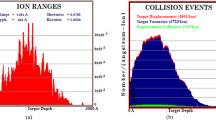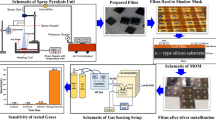Abstract
Hydrogenated amorphous indium-tin-oxide (ITO) thin films have been prepared using reactive gas-timing DC magnetron sputtering technique, onto externally unheated glass substrate and without any heat treatment. In order to study the effect of hydrogen on the microstructural and optoelectrical properties of the ITO films, an additional hydrogen input line is added to the sputtering system and the hydrogen partial flow rate in the plasma gas mixture is varied over the range 0–0.9 sccm, while the other sputtering parameters are kept constant and optimized during the film growth. The optimized parameters are found to be 100 W DC power, 25 mTorr working pressure, and 7 cm electrode spacing. Introduction of the reactive hydrogen into the deposition chamber is achieved using uniform and step profiles. Characterization of the deposited hydrogenated amorphous ITO thin films are made using X-ray diffraction (XRD), atomic force microscopy (AFM), four probe electrical conductivity, photoluminescence (PL), and UV–Visible spectroscopy. A minimum sheet resistance of 8.34 \(\Omega\)/square, transmittance of 81.6% with a Haackes figure of merit of \(15.7 \times {10^{ - 3}}\) \({\Omega ^{ - 1}}\), thickness of 380 nm, and optical band gap of 4.02 eV are obtained for the hydrogenated thin film prepared by uniform introducing profile of hydrogen reactive gas at 0.1 sccm hydrogen flow rate.











Similar content being viewed by others
References
T. Koida, H. Fujiwara, M. Kondo, Hydrogen-doped In2O3 as high-mobility transparent conductive oxide. Jpn. J. Appl. Phys. 46, 25–28 (2007)
Y.H. Tak, K.B. Kim, H.G. Park, K.H. Lee, J.R. Lee, Criteria for ITO (indium-tin-oxide) thin film as the bottom electrode of an organic light emitting diode. Thin Solid Films 411, 12–16 (2002)
J.B. Chu, S.M. Huang, H.B. Zhu, X.B. Xu, Z. Sun, Y.W. Chen, F.Q. Huang, Preparation of indium tin oxide thin films without external heating for application in solar cells. J. Non-Cryst. Solids 354, 5480–5484 (2008)
H.L. Hartnagel, A.L. Dawar, A.K. Jain, C. Jagadish, Semiconducting transparent thin films (Institute of Physics, Bristol, 1995)
M.G. Varnamkhasti, V. Soleimanian, Microstructure, electrical and optoelectronic characterizations of transparent conductive nanocrystalline In2O3: Sn thin films. J. Mater. Sci.: Mater. Electron. 26, 3223–3230 (2016)
M. Gulen, G. Yildirim, S. Bal, A. Varilci, I. Belenli, M. Oz, Role of annealing temperature on microstructural and electro-optical properties of ITO films produced by sputtering. J. Mater. Sci.: Mater. Electron. 24, 467–474 (2013)
G. Zhu, Z. Yang, Effect of sputtering power and annealing temperature on the properties of indium tin oxide thin films prepared from radio frequency sputtering using powder target. J. Mater. Sci.: Mater. Electron. 24, 3646–3651 (2013)
S.D. Senol, A. Senol, O. Ozturk, M. Erdem, Effect of annealing time on the structural, optical and electrical characteristics of DC sputtered ITO thin films. J. Mater. Sci.: Mater. Electron. 25, 4992–4999 (2014)
D.S. Ginley, C. Bright, Transparent conducting oxides. MRS Bull. 25, 15–18 (2000)
C.G. Granqvist, A. Hultaker, Transparent and conducting ITO films: new developments and applications. Thin Solid Films 411, 1–5 (2002)
S. Lany, A. Zunger, Dopability, intrinsic conductivity, and nonstoichiometry of transparent conducting oxides. Phys. Rev. Lett. 98, 045501 (2007)
S. Luo, K. Okada, S. Kohiki, F. Tsutsui, H. Shimooka, F. Shoji, Optical and electrical properties of indium tin oxide thin films sputter-deposited in working gas containing hydrogen without heat treatments. Mater. Lett. 63, 641–643 (2009)
S. Ishibashi, Y. Higuchi, Y. Ota, K. Nakamura, Low resistivity indiumtin oxide transparent conductive films. II. Effect of sputtering voltage on electrical property of films. J. Vac. Sci. Technol. A 8, 1403 (1990)
S.N. Luo, A. Kono, N. Nouchi, F. Shoji, Effective creation of oxygen vacancies as an electron carrier source in tin-doped indium oxide films by plasma sputtering. J. Appl. Phys. 100, 113701 (2006)
S. Luo, S. Kohiki, K. Okada, F. Shoji, T. Shishido, Hydrogen effects on crystallinity, photoluminescence, and magnetization of indium tin oxide thin films sputter-deposited on glass substrate without heat treatment. Phys. Status Solidi A 207(2), 386–390 (2010)
M. Marikkannan, M. Subramanian, J. Mayandi, M. Tanemura, V. Vishnukanthan, J.M. Pearce, Effect of ambient combinations of argon, oxygen, and hydrogen on the properties of DC magnetron sputtered indium tin oxide films. AIP Adv. 5, 017128 (2015)
K. Okada, S. Kohiki, S. Luo, D. Sekiba, S. Ishii, M. Mitome, A. Kohno, T. Tajiri, F. Shoji, Correlation between resistivity and oxygen vacancy of hydrogen-doped indium tin oxide thin films. Thin Solid Films 519, 3557–3561 (2011)
H. Morikawa, M. Fujita, Crystallization and electrical property change on the annealing of amorphous indium-oxide and indium-tin-oxide thin films. Thin Solid Films 359, 61–67 (2000)
J.H.W. Dewit, G. Vanunen, M. Lahey, Electron concentration and mobility in In2O3. J. Phys. Chem. Solids 38, 819–824 (1977)
J. Wallinga, W.M. Arnold Bik, A.M. Vredenberg, R.E.I. Schropp, W.F. van der Weg, Reduction of tin oxide by hydrogen radicals. J. Phys. Chem. B 102, 6219–6224 (1998)
S. Luo, S. Kohiki, K. Okada, A. Kohno, T. Tajiri, M. Arai, S. Ishii, D. Sekiba, M. Mitome, F. Shoji, Effects of hydrogen in working gas on valence states of oxygen in sputter-deposited indium tin oxide thin films. ACS Appl. Mater. Interfaces 2, 663–668 (2010)
M. Shakiba, A. Kosarian, E. Farshidi, Effects of processing parameters on crystalline structure and optoelectronic behavior of DC sputtered ITO thin film. J. Mater. Sci.: Mater. Electron. 28, 787–797 (2017). doi:10.1007/s10854-016-5591-1
A.E.H.B. Kashyout, M. Fathy, M.B. Soliman, Studying the properties of RF-sputtered nanocrystallinetin-doped indium oxide. Int. J. Photoenergy 2011, 6 (2011)
Y. Chen, Y. Zhou, Q. Zhang, M. Zhu, F. Liu, The correlation between preferred orientation and performance of ITO thin films. J. Mater. Sci.: Mater. Electron. 18, S411–S414 (2007)
Powder Diffraction File, Joint Committee on Powder Diffraction Standards, ASTM, Philadelphia, PA, 1967, Card 6-0416
F.O. Adurodija, H. Izumi, T. Ishihara, H. Yoshioka, M. Motoyama, Effects of stress on the structure of indium-tin oxide thin films grown by pulsed laser deposition. J. Mater. Sci.: Mater. Electron. 12, 57–61 (2001)
P. Nath, R.F. Bunshah, B.M. Basol, O.M. Staffsud, Electrical and optical properties of In2O3: Sn films prepared by activated reactive evaporation. Thin Solid Films 72, 463–468 (1980)
S. Honda, A. Tsujimoto, Depth profiling of oxygen concentration of indium tin oxide films fabricated by reactive sputtering. Jpn. J. Appl. Phys. 33, 9A (1994)
K. Zhang, F. Zhu, C.H.A. Huan, A.T.S. Wee, Effect of hydrogen partial pressure on optoelectronic properties of indium tin oxide thin films deposited by radio frequency magnetron sputtering method. J. Appl. Phys. 86, 974 (1999)
A. Dixit, C. Sudakar, R. Naik, V.M. Naik, G. Lawes, Undoped vacuum annealed In2O3 thin films as a transparent conducting oxide. Appl. Phys. Lett. 95, 192105 (2009)
T. Ohno, T. Kawahara, H. Tanaka, T. Kawai, M. Oku, K. Okada, S. Kohiki, Ferromagnetism in transparent thin films of Fe-doped indium tin oxide. J. Appl. Phys. 45, 33–36 (2006)
M. Ando, E. Nishimura, K.-I. Onisawa, T. Minemura, Effect of microstructures on nanocrystallite nucleation and growth in hydrogenated amorphous indium-tin-oxide films. J. Appl. Phys. 93, 1032 (2003)
V.G. Karpov, Nucleation in disordered media. Phys. Rev. B 50, 9124 (1994)
A.B. Pevtsov, V.Y. Davydov, N.A. Feoktistov, V.G. Karpov, Nanoscale-crystallite nucleation and growth in amorphous solids. Phys. Rev. B 52, 955 (1994)
X.C. Wu, J.M. Hong, Z.J. Han, Y.R. Tao, Fabrication and photoluminescence characteristics of single crystalline In2O3 nanowires. Chem. Phys. Lett. 373, 28–32 (2003)
M.J. Zheng, L.D. Zhang, G.H. Li, X.Y. Zhang, X.F. Wang, Ordered indium-oxide nanowire arrays and their photoluminescence properties. Appl. Phys. Lett. 79, 839 (2001)
S. Kar, S. Chaudhuri, Synthesis, photoluminescence and field emission properties of In2O3 nanowires. Chem. Phys. Lett. 422, 424–428 (2006)
P. Guha, S. Kar, S. Chaudhuri, Direct synthesis of single crystalline In2O3 nanopyramids and nanocolumns and their photoluminescence properties. Appl. Phys. Lett. 85, 3851 (2004)
C.H. Liang, G.W. Meng, Y. Lei, F. Phillipp, L.D. Zhang, Catalytic growth of semiconducting In2O3 nanofibers. Adv. Mater. 13, 1330 (2001)
H.J. Zhou, W.P. Cai, L.D. Zhang, Photoluminescence of indium-oxide nanoparticles dispersed within pores of mesoporous silica. Appl. Phys. Lett. 75, 495 (1999)
L. Dai, X.L. Chen, J.K. Jian, M. He, T. Zhou, B.Q. Hu, Fabrication and characterization of In2O3 nanowires. Appl. Phys. A 75, 687 (2002)
M.-S. Lee, W.C. Choi, E.K. Kim, C.K. Kim, S.-K. Min, Characterization of the oxidized indium thin films with thermal oxidation. Thin Solid Films 279, 1–3 (1996)
D.K. Shroder, Semiconductor material and device characterization (Wiley, New York, 1990)
J.I. Parkove, Optical process in semiconductors (Dover Publications Inc, New York, 1971)
G. Haacke, New figure of merit for transparent conductors. J. Appl. Phys. 47, 4086 (1976)
Acknowledgements
This research was supported by Khuzestan Regional Electric Company, Ahvaz, Iran.
Author information
Authors and Affiliations
Corresponding author
Rights and permissions
About this article
Cite this article
Kosarian, A., Shakiba, M. & Farshidi, E. Role of hydrogen treatment on microstructural and opto-electrical properties of amorphous ITO thin films deposited by reactive gas-timing DC magnetron sputtering. J Mater Sci: Mater Electron 28, 10525–10534 (2017). https://doi.org/10.1007/s10854-017-6826-5
Received:
Accepted:
Published:
Issue Date:
DOI: https://doi.org/10.1007/s10854-017-6826-5




